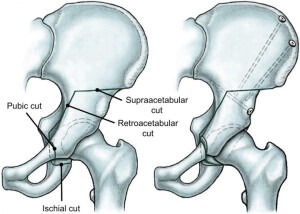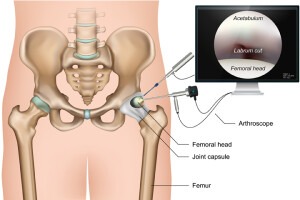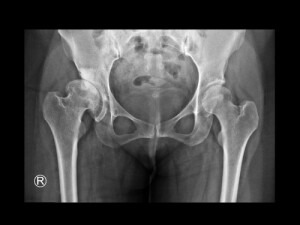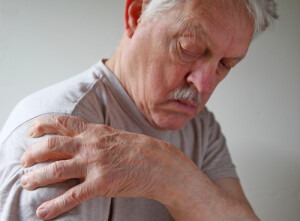Periacetabular Osteotomy
Periacetabula Osetotomy or PAO surgery is used for correcting acetabular dysplasia or hip dysplasia. Hip dysplasia refers to a condition where there is insufficient coverage of the hip socket ball (femoral head) because of a shallow hip socket (acetabulum).
The acetabulum, during PAO, gets repositioned to cover the femoral head properly. This helps in improving the hip joint stability. PAO surgery decreases hip pain, improves hip function and stops further damage inside the joint, which may lead to hip arthritis.
Board certified orthopedic surgeon Dr. Tigran Garabekyan provides hip surgery to patients in Los Angeles, Century City, CA, and surrounding locations.
Surgical Procedure
 PAO may be considered for patients with mild hip dysplasia that have not yet reached skeletal maturity. They should also suffer from acetabulum malalignment but not advanced osteoarthritis. PAO is popularly recommended for patients with milder forms of hip dysplasia. This is especially true when other surgeries, such as a hip arthroscopy have failed.
PAO may be considered for patients with mild hip dysplasia that have not yet reached skeletal maturity. They should also suffer from acetabulum malalignment but not advanced osteoarthritis. PAO is popularly recommended for patients with milder forms of hip dysplasia. This is especially true when other surgeries, such as a hip arthroscopy have failed.
Hip arthroscopy is useful in repairing the labrum. However, it doesn’t correct dysplasia. Your surgeon will take into account your lifestyle and age while deciding to proceed with a PAO surgery. You should also discuss your individual expectations and goals.
The surgeon, during a periacetabular osteotomy, will make a series of cuts on the bone to reposition your acetabulum within the pelvis. This will be done for restoring your anatomy to a more normal position. Your bones will then have screws for stabilizing the position. New bone will form during the healing process across the cuts made to secure the acetabulum within the pelvis. This will help establish a proper alignment of the hip socket and ball joint.
Femoral osteotomy is necessary for correcting malalignment of the femur in almost 10% patients. This is the case with the neck and head of the femur. In select patients, PAO may be performed along with hip arthroscopy. For instance, the surgery may be performed for repairing a damaged labrum.
X-ray guidance will be used throughout the surgery. Muscles and nerves supporting and surrounding the hip joint will be carefully protected.
Recovery and Results
Patients undergoing PAO may require hospitalization for 2 – 4 days. Instructions and physical therapy will be provided to you in addition to weight-bearing guidelines. You may need to use crutches for 6 – 8 weeks. Most patients can return to their work or school after three months for resuming athletics after 6 – 12 weeks. Surgery in the case of dysplasia that affects both hips will be performed 4 – 6 months apart.
PAO yields great results in patients that are ideal candidates and have not yet developed significant hip joint arthritis. This is true even after 20 – 25 years post-surgery. PAO when performed by a skilled orthopedic surgeon is safe and results in predictable outcomes. You should get the surgery performed by an experienced surgeon at a center that deals with a lot of hip patients.
A specialist in orthopedic surgery of the hip, Dr. Garabekyan receives patients from Los Angeles, Century City, CA, and nearby areas for safe and proven hip procedures.
Contact the Southern California Hip Institute
Dr. Tigran Garabekyan is a board certified orthopedic surgeon specializing in hip preservation. To learn more about Southern California Hip Institute or to schedule a consultation, click here to contact us or call:
Century City / Los Angeles: 310.574.0375
Serving patients in Los Angeles, Beverly Hills, Santa Monica, Century City, West Hollywood, North Hollywood Encino, Sherman Oaks, Van Nuys, Burbank, Glendale and other neighboring cities in the greater Los Angeles, California area.
Also visit http://www.drgorthopedics.com/


 Doctors can use hip arthroscopy for viewing the hip joint without having to make a large incision through the soft tissues. Arthroscopy is used for diagnosing and treating a broad range of hip troubles. The surgeon will insert a small camera in the hip joint. This camera is called an arthroscope. Pictures will be displayed by the camera on a video monitor. Your surgeon will guide miniature surgical instruments using these images.
Doctors can use hip arthroscopy for viewing the hip joint without having to make a large incision through the soft tissues. Arthroscopy is used for diagnosing and treating a broad range of hip troubles. The surgeon will insert a small camera in the hip joint. This camera is called an arthroscope. Pictures will be displayed by the camera on a video monitor. Your surgeon will guide miniature surgical instruments using these images. The human hip is in the form of a ball-and-socket joint. A part of the pelvis bone called the acetabulum forms the socket. The femoral head makes the ball which makes the upper end of the thighbone or femur.
The human hip is in the form of a ball-and-socket joint. A part of the pelvis bone called the acetabulum forms the socket. The femoral head makes the ball which makes the upper end of the thighbone or femur. Hip dysplasia refers to a condition in which the hip socket is abnormally shaped and doesn’t cover the upper thighbone’s ball portion. The hip joint in this case becomes completely or partially dislocated. People suffering from hip dysplasia in most cases are born with it.
Hip dysplasia refers to a condition in which the hip socket is abnormally shaped and doesn’t cover the upper thighbone’s ball portion. The hip joint in this case becomes completely or partially dislocated. People suffering from hip dysplasia in most cases are born with it. Hip labral tear involves injury to the labrum or the ring of cartilage following the outside rim of the hip joint socket. Labrum cushions the hip joint and acts like a gasket or a rubber seal to help hold the ball securely within the hip socket at the top pf the thighbone.
Hip labral tear involves injury to the labrum or the ring of cartilage following the outside rim of the hip joint socket. Labrum cushions the hip joint and acts like a gasket or a rubber seal to help hold the ball securely within the hip socket at the top pf the thighbone. Hip orthopedic surgery is a complex procedure, which should only be performed by a qualified and committed surgeon. For your own safety and health, make no compromise on the choice of your surgeon for a hip procedure.
Hip orthopedic surgery is a complex procedure, which should only be performed by a qualified and committed surgeon. For your own safety and health, make no compromise on the choice of your surgeon for a hip procedure. syndrome.
syndrome.  Individuals with SI joint dysfunction can suffer from pain and impaired function. It is vital to understand that SI joint pain symptoms can be akin to those of other conditions of the pelvis, lumbar spine, and hip. The patient will require an SI joint exam to diagnose the source of the pain correctly.
Individuals with SI joint dysfunction can suffer from pain and impaired function. It is vital to understand that SI joint pain symptoms can be akin to those of other conditions of the pelvis, lumbar spine, and hip. The patient will require an SI joint exam to diagnose the source of the pain correctly.  For people diagnosed with SI joint dysfunction, which can cause one or both of the SI joints to become painful, the doctor may initially consider non-surgical treatments, such as medicines, physical therapy, or steroid injections.
For people diagnosed with SI joint dysfunction, which can cause one or both of the SI joints to become painful, the doctor may initially consider non-surgical treatments, such as medicines, physical therapy, or steroid injections. 


